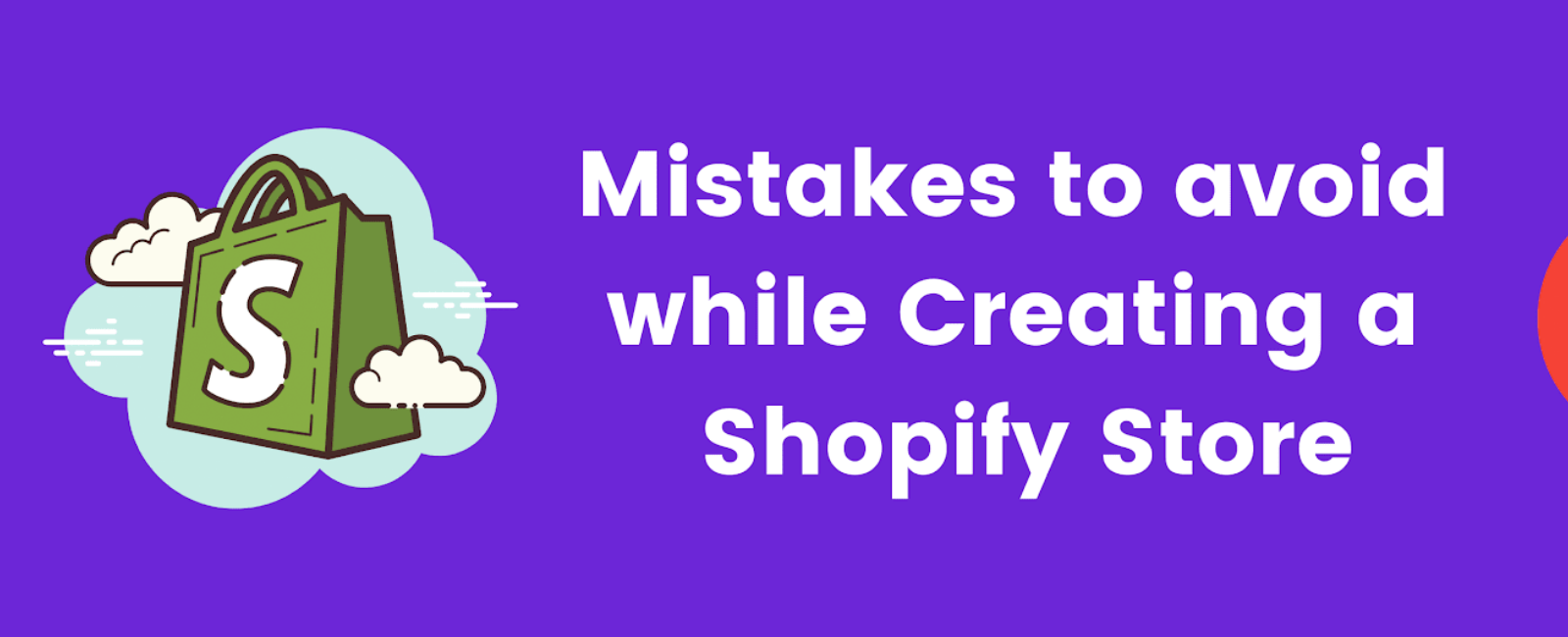Common Mistakes to Avoid While Creating a Shopify Store
Trying to perfect your Shopify store? Well, keep an eye on some of these common mistakes to dodge.

The trend of eCommerce stores is at an all-time high, with prospects to reach new heights. Among all the major platforms launched over the years, Shopify has rightly held its place as the third largest with over 1.75 million sellers and one of the best eCommerce platforms. Supporting more than 600,000 businesses across 175 countries, Shopify is the trend for budding online businesses.
However, the mountain of tasks required to complete before the launch of your Shopify store is often confusing for new users on the Shopify trial.
So, are you new to launching your Shopify business?
Or, want a walk through to the process of creating a Shopify store?
Either way, by the end of this guide, you’ll learn the A-Z of the common mistakes to avoid while creating a Shopify store. Let's dive deeper and understand the top 20 Shopify store mistakes anyone can make, as well as some tips on personalizing your approach and shopify theme development.

Let's get started!
Top 20 Common Mistakes to Avoid While Creating a Shopify Store
1. Thinking If you have an online store, traffic will follow
Things work differently over the eCommerce stores. If you think that setting up an online store gets the job done, it's time you think again.
The internet is home to millions of exceptional websites crafted to attract visitors. However, even the most pleasing design can't guarantee you visitors, unless you have your brand promotions placed strategically!
Therefore, to ensure your website's success, it's essential to keep working on its promotion and optimization. Engaging professional Shopify development services can provide the expertise needed to effectively optimize and promote your store, ensuring it stands out in the competitive online marketplace.
Try Soft Launch of Your Site - Don't just bombard your store with a grand online opening; instead, invite a limited number of your friends, colleagues, and close members for a 'soft launch.' This way, you can easily work on the feedback of your stores and optimize them accordingly.
2. Not knowing who your ideal customer is
Selling without knowing your target customers is like shooting an arrow in the dark. You will undoubtedly sell your product/services, but you will fail to impact the long run.
Searching for your ‘ideal customer’ is like reaching out to the specific end-user target - one who is more likely to avail of your product or services.
Further, when you know your ideal customer, you can easily create a buyer’s persona and target only the required segment of users, saving you on marketing budgets and other financial investments.
The more you understand your customer, the better you sell your product.
Tip: Once you know who your ideal customers are, try segregating them based on different parameters.
3. Not having a solid marketing plan
Not having a solid marketing plan counts for the biggest Shopify store mistakes. A sound marketing plan is the essence of your entire online business on Shopify stores. Having a pre-defined marketing plan is knowing your future target audience and all the objectives (short-term and long-term), among others.
Most importantly, having a sound marketing plan is like executing the scalability of your operations in advance.
Confused over the options to include in your marketing plan? Here's a heads up of the pointers to define in your strategy:
- Brand message and USP
- Target audience
- Current reach and future objectives
- Marketing tactics
Tip: Don't forget to incorporate a 'consumer view' (how your consumers will perceive your brand) while setting up your strategy.
4. Having improper branding
Incomplete branding is one of the most common mistakes to avoid while creating a Shopify store. When you leave your branding in bits and pieces, you are at a higher chance of losing your potential clients.
We know that nobody would love such a sight, therefore, to help you out with the same, listed below are some things to consider:
- Include Logo - Your logo is the brand identity of your company. When your Shopify store misses a logo, it fails to leave its unique print, and customers will fail to remember it, even after a grand opening.
Tip: We suggest you get a professionally designed logo to present your brand over the internet.
- Be consistent about Theme Colour - Let's face it; nobody likes to see varied colored themes over online stores. Having various color consistency often leads to confusion and fails to leave a mark for visitors.
Tip: Use dual-color themes or go for three colors at max. Don't incorporate bold colors; try creating a contrast.
- Use Single Font - With a wide variety of free fonts at your disposal, it is only daunting to select the one that will highlight your store. Further, using multiple fonts takes away the engagement of a website.
Tip: Shortlist either two or three fonts and select one that perfectly fits your store. If you are worried about creating different looks, it can be quickly done using capitalization, letter spacing, and bold and regular options.
5. Having non-optimized images
Yet another Shopify store mistake that you can easily commit is to not optimize the product images in your store. When you don't optimize your images, they take a higher loading time, reducing traffic and engagement over your Shopify store.
However, when you resize your images, you add on to your website's loading speed and boost it for the better.
Tip: Always resize and compress your images using different apps/tools and get a preview of the size before finalizing your products on your Shopify store.
6. Having empty about us & contact us page
One of the most-visited parts of the site, the About Us and Contact Us options top the list as one of the most viewed elements of a page. You can't miss it. Not filling/partial completion of your 'About Us' can be your biggest Shopify store mistake.
No matter if you have just created your Shopify account or have a small startup, introducing your business should be your first thing on the to-do list. When you fill-up the About us page with relevant contact and email information, you provide your viewers with an insight into your business, building loyalty and trust among customers.
Tip: Your 'About Us' section should include a story about your brand, helping you develop a unique appeal to your customers.
7. Keeping SEO options as default
SEO (Search Engine Optimization) is one of the most crucial elements for your brand's digital promotion and marketing. While Shopify provides its users with default options for SEO, we suggest you remove the default options.
When you customize your page for SEO, you open the possibilities of better page ranking.
Tip: Make sure you optimize every page of your blog with relevant meta tags that allow SEO. We also suggest using relevant keywords that help crawlers fetch you higher rankings on google search results.
8. Not using any payment methods
Using limited or no payment methods is an excellent turn-off for your visitors and results in decreased sales as many customers prefer making their payments online.
Therefore, to ensure that you don't miss out on all the possible avenues for generating sales, integrate your Shopify store with all the possible payment gateways.
Tip: If you are not sure about third-party payment methods, you can also use the Shopify payment gateway in your online store.
9. Ignoring mobile visitors
Today, mobile phone users top the chart. Carrying over 80% of traffic, mobile visitors are the most significant source of website engagement in the current scenario.
Having said that, are you sure about considering your mobile visitors?
Tip: When designing your store, make sure that your website is adaptive to both mobile and desktop versions. Further, you can also consider using mobile responsive themes and swipeable product images and create interactive UI for your mobile visitors.
10. Not showing social proof
Social proof is your tool for conversion. Having them displayed on your website improves goodwill and vouches for your genuineness to your visitors. However, the key to using social proof is time.
If you leverage your social proofs at the right time and accurate level of your campaign, conversions are guaranteed.
Interestingly, there are not one but three common ways to leverage social proof on your Shopify store. These include -
- Feature customer reviews.
- Give space to some user-generated content on your page.
- On to your blog posts by including CTAs.
Tip: Don't rush behind adding your social proofs if you have just launched your Shopify store. Wait until you have a customer base and begin by adding reviews as products with zero or no reviews make buyers suspicious of their quality. However, you should also avoid forged social proofs to gain the trust of your customers.
11. Not setting up Google Analytics
One of the most common mistakes to avoid while creating a Shopify store is not setting up Google Analytics, as and how the eCommerce platform suggests it.
Ensure that you follow all the guides and set up your Google Analytics account correctly to initiate sales in your Shopify account.
12. Showing high delivery charges
Human psychology is applicable in almost every aspect of marketing, even when we set up our Shopify stores. The sight of 'extra for shipping' at eCommerce stores is what makes most of us abandon our cart, then and there.
Therefore, you must keep your shipping free and determine the overall amount required to avail of such services. Further, you should also try to deliver your products at the earliest and avoid the trap of 'LONG DELIVERY TIMES.'
Tip: Never break your shipping charges if the products are expensive to ship; instead, include all the shipping expenses on the total product price.
13. Having a complicated check out process
Another Shopify store mistake that leads to an increased cart abandonment rate is the complicated checkout process. While having more fields might provide you with relevant data for target customers, it might often become a jigsaw when you design multiple fields, losing sight of engagement.
You should always focus on keeping your checkout process simple and confined to a defined number of steps.
Tips:
- Confine your checkout steps to a bare minimum (2-3 steps)
- Only collect data that is crucial
- Test and reshuffle your payment processor
14. Not welcoming first-time visitors
'The first impression is the last impression,' a proverb that sets in almost every situation, even when designing your Shopify store. Not welcoming your first-time visitors is one of the most common mistakes to avoid while creating a Shopify store. The way to engage your visitors has a lot to do with what follows (if they stay and browse your site or exit).
The way you welcome your visitor plays a significant role in enhancing a bond between a buyer and a brand. Remember, no matter how or what you offer, nothing will make an impact until you work on enticing your visitors over the landing page.
Tip:
While you design your website, make sure you:
- Precise about the message that your landing page wants to give to your visitors.
- Stick to theme and color contrast that is appealing and pleasing.
- Make sure you integrate pop-ups to add the element of a 'welcoming vibe.'
- Greet your prospects over email as well (once you are successful in securing contact information).
15. Not making use of newsletter subscriptions wisely
Newsletters are one of the best marketing tools offered by Shopify, therefore, it is essential that you use them wisely. When you use your newsletter subscriptions in a strategized manner, your brand has a higher chance of engaging with customers (existing or potential).
Tip: Try to integrate your subscriber list URL and segregate customers based on their likes and tastes.
16. Not adding value to the customers
Perhaps, not considering the value of your customers is a Shopify mistake that can be easily corrected. Today, every individual buyer who purchases your eCommerce plays a big role in driving business decisions.
Your customers are your key players; therefore, you should always add value to the customer and add on to their experiences.
Tip:
You can easily add value to your customers by incorporating the follows:
- Special discount coupons to first-time shoppers
- Free shipping on orders above a specified price range
- Setting up loyalty rewards for your store
- Designing an interactive UI.
17. Not optimizing important landing pages for conversion
Not optimizing your Landing Pages for the conversion is one of the Shopify store mistakes you can easily avoid.
When you optimize your Shopify landing pages for conversion, you are ready for conversions that can occur over different channels. You can do the same by tweaking around some of your page elements or work with the reviews and feedback provided by the customers.
Or, try out the following examples:
- Make your customers feel appreciated by offering them a clear offer that aligns to their goals.
- Try and make use of contrasting colours on your landing page, allowing the CTA to pop up while viewing the page.
18. Not reducing cart abandonment rates
Cart abandonment has been a massive blow to the revenues of almost every eCommerce platform that is available over Shopify and other such platforms. In today's competitive world, it's hard to simulate a purchase.
While cart abandonment can't be eliminated but when you tweak your website and campaigns by a bit, the results will surely be better.
Tip:
- Allow multiple payment options
- Simple checkout process
- Try giving attractive offers to your interested prospects
- Make use of clear CTAs in your emails (try creating the factor of a rush)
19. Not using influencer marketing properly
Influencer marketing, when used properly, can help you increase the sales number. Moreover, when you try to market your products using influencers, you can even work on a cost-effective marketing strategy.
However, you must evaluate your influencer's monthly reach and existing partnerships to get a better idea of the results they can bring.
Tip: Narrow your goals and be specific about the message you want them to put out.
20. Not taking accounting seriously
Accounting is the essence of every business that exists. If you don't keep track of all the expenditure, sales, and growth of your Shopify, you will never understand where you are heading (profit/loss).
When you don't take your accounting seriously, you might give a push to a domino effect over your taxes, expenses, and income. Further, Shopify also allows users to integrate their shops with third-party apps to automate accounting.
Conclusion
Mistakes are a part of learning; they should never stop you from learning or trying something new. Similarly, like other mistakes listed above, 20 of the most common mistakes committed by owners and creators of Shopify stores can have a huge impact and reduce your online sales instead of improving them.
So, try avoiding these mistakes in your online business while simultaneously learning and adapting to your business's aspects.
Additional resources on Shopify
